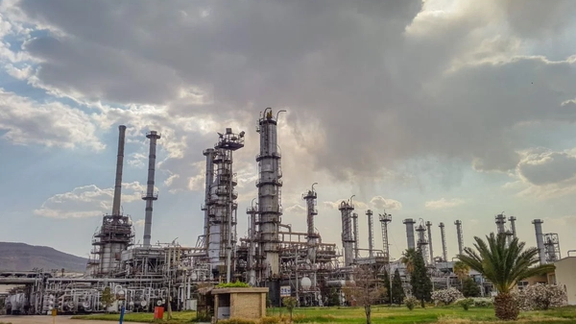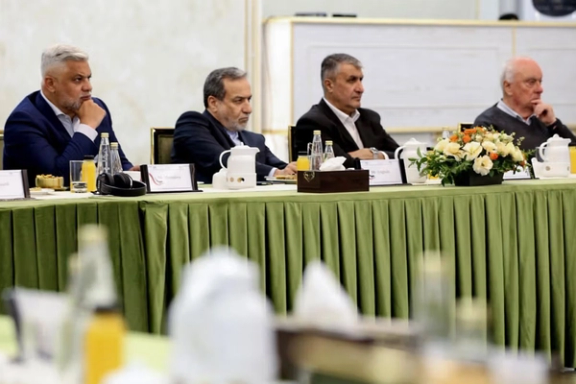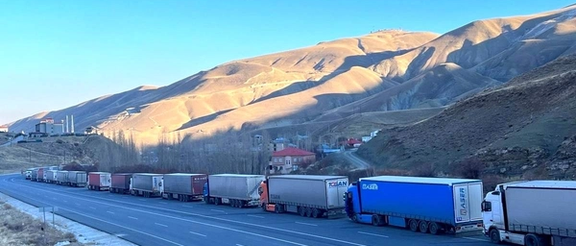Gas leak in Iranian refinery kills two, injures nine - state media

A gas leak at a refinery in Fars Province on Saturday resulted in the deaths of two workers and left nine others injured, state-run media outlets reported citing local officials.

A gas leak at a refinery in Fars Province on Saturday resulted in the deaths of two workers and left nine others injured, state-run media outlets reported citing local officials.
"Nine of the injured were promptly transferred to hospitals in Shiraz and Zarqan with the help of emergency response teams," said Hojjatollah Rezaei, the deputy governor of Fars for political and security affairs.
He said the injured workers are fortunately in stable condition.
“The two victims suffered severe inhalation of hazardous substances, which led to suffocation and ultimately cost them their lives,” Rezaei confirmed.
The Shiraz refinery is operating without interruption, the official said, adding that an investigation into the cause of the incident is currently underway.
The Shiraz Refinery (also known as SORC) is a crude oil refinery located on the Shiraz-Isfahan road. It is designed to process 40,000 barrels of crude oil per day, equivalent to 2 million tons per year.
The required crude oil feed is supplied via a 230-kilometer, 10-inch pipeline from the Gachsaran oil fields.

Iran has strongly rejected as unbalanced and politically motivated the latest report by the International Atomic Energy Agency (IAEA) which accuses Tehran of running an undeclared nuclear program using unreported material.
Details of the UN nuclear watchdog's report were released by Reuters earlier in the day, at a delicate moment as Tehran and Washington have engaged in multiple rounds of negotiations in recent weeks over a potential nuclear agreement that US President Donald Trump is seeking to finalize.
In a joint statement on Saturday, the Iranian Foreign Ministry and the Atomic Energy Organization of Iran (AEOI) accused IAEA Director General Rafael Grossi of "repeating groundless accusations based on forged documents provided by the Zionist regime (Israel)."
“The allegations raised by the IAEA are based on claims regarding a handful of undeclared activities and locations from decades ago,” the statement read. “Iran has repeatedly declared that it has never had any undeclared nuclear site or activity.”
In 2018, Israel officially claimed responsibility for the theft of Iran's nuclear documents from a warehouse in Tehran's Shourabad area – with Benjamin Netanyahu revealing that Israel had obtained 55,000 pages and 55,000 digital files through an intelligence operation.
Iran's Saturday statement condemned what it called the IAEA’s double standards regarding Israel. “The report relies on unverified information from a regime that is not even a party to the NPT, possesses nuclear weapons, and openly threatens Iran’s peaceful nuclear facilities"
The statement also criticized the IAEA's report for failing to accurately reflect Iran’s cooperation with the Agency. “Despite acknowledging Iran’s cooperation, the report does not portray the real level of engagement. Iran has provided access, allowed sampling, and offered extensive explanations on the sites in question."
Tehran accused Western powers of exploiting the Agency for political ends. “The United States, the United Kingdom, France, and Germany have repeatedly violated their commitments under the JCPOA and Resolution 2231. At the same time, they continue to impose illegal sanctions and pressure Iran in violation of international law.”
Sharp rise in highly enriched uranium stockpiles
The IAEA, in a separate report sent to member states on Saturday, revealed a sharp rise in Iran’s stockpile of enriched uranium. As of May 17, Iran held 408.6 kilograms of uranium enriched to 60 percent, an increase of 133.8 kilograms since February, the report said. Material enriched to that level is a short technical step from weapons-grade purity.
The Iranian government on Saturday stressed the peaceful nature of its nuclear program and reaffirmed its intention to continue working with the Agency within the framework of its legal obligations.
“Iran’s enrichment program is exclusively for peaceful purposes, under full IAEA oversight and in line with the Comprehensive Safeguards Agreement,” the statement added.
Iran warned that any attempt to use the report against it during the upcoming Board of Governors meeting would trigger a response.
“Should some states misuse the report or Iran’s transparent cooperation to increase pressure, the Islamic Republic will take appropriate measures to protect its legitimate rights and interests,” the statement said.

Iran operated a covert nuclear program using undeclared material at three sites under investigation, the International Atomic Energy Agency said in a confidential report shared with member states ahead of its board meeting in June.
“These three locations, and other possible related locations, were part of an undeclared structured nuclear program carried out by Iran until the early 2000s,” the report said, adding that “some activities used undeclared nuclear material.”
The report comes at a delicate moment, as Tehran and Washington have engaged in multiple rounds of negotiations in recent weeks over a potential nuclear agreement that US President Donald Trump is seeking to finalize.
The document, obtained by Reuters, was prepared following a November request by the IAEA’s Board of Governors.
UN nuclear agency flags sharp rise in Iran’s high-level uranium
The IAEA, in a separate report sent to member states on Saturday, said a sharp rise in Iran’s stockpile of enriched uranium. As of May 17, Iran held 408.6 kilograms of uranium enriched to 60 percent, an increase of 133.8 kilograms since February. Material enriched to that level is a short technical step from weapons-grade purity.
“Iran is the only non-nuclear weapon state enriching to this level,” IAEA Director General Rafael Grossi has repeatedly said. On Saturday, he again urged Iran to cooperate “fully and effectively with the agency.”
Both IAEA reports said Iran’s high-level enrichment was “of serious concern,” noting it is the only country enriching to that level without having nuclear weapons.
Western powers move toward censure
Western governments are also preparing a resolution that would formally declare Iran in breach of its non-proliferation commitments for the first time since 2005. Reuters cited diplomats on Friday as saying the United States will lead the drafting of the motion, to be submitted at the board’s quarterly meeting beginning June 9.
“We expect the comprehensive report to be tough, but there were already no doubts over Iran not keeping its non-proliferation commitments,” a European official told Reuters.
The last time the IAEA board took such action, in 2005, it led to Iran’s referral to the UN Security Council and triggered a round of international sanctions.

Iran’s nuclear chief said on Saturday that indirect negotiations with the United States have made “some progress,” but dismissed any demand to eliminate uranium enrichment as “a disturbed dream” meant for Israeli audiences.
“Talk of zero enrichment is mostly for the Zionist community,” Atomic Energy Organization head Mohammad Eslami said during a visit to northern Iran. “These are rumors with no bearing on the realities of the talks.”
The fifth round of indirect talks between Tehran and Washington took place last week in Rome, part of ongoing efforts mediated by Oman since April.
Eslami said Iran remains committed to expanding its nuclear energy program, including new reactors and domestic production of radiopharmaceuticals. He emphasized that the program is peaceful and transparent, despite what he called foreign pressure.
Tehran signals no retreat on enrichment
Echoing that stance, Foreign Minister Abbas Araghchi said earlier on Saturday that uranium enrichment has always been a red line for Iran. “The right to enrichment is tied to rejecting domination — no one in Iran will accept being told we don’t have this right,” he said during a visit to Ruhollah Khomeini's mausoleum. Araghchi added that Tehran has consistently upheld its position in both past and present negotiations.
Araghchi also repeated that Iran considers nuclear weapons religiously and strategically unacceptable. “We’ve always been a standard-bearer of nuclear disarmament,” he said, accusing Western nuclear states of failing to uphold their obligations under the Non-Proliferation Treaty.
MPs say enrichment is non-negotiable
In parliament, lawmakers are voicing firm support for the government’s nuclear position. “The negotiating team has moved forward well within the defined red lines,” said Ebrahim Azizi, head of the national security and foreign policy committee. “Enrichment is a foundational right — we’ve never negotiated over the principle of enrichment, and we won’t.”
Mehdi Esmaeili, a conservative MP from Miyaneh, also warned that “external pressure will never force Iran to retreat from its rights.” He said Iran’s pursuit of a full nuclear fuel cycle is “a strategic goal of the revolution” and rooted in national consensus.
Trump: Iran deal could happen soon
At the White House on Friday, US President Donald Trump said he believed a deal with Iran could be reached “in the not-too-distant future.” He argued that Iran “does not want to be blown up” and would prefer to resolve the standoff diplomatically.
“If we can have a deal without bombs being dropped all over the Middle East, that would be a very good thing,” Trump told reporters. “We want them to have a successful, safe nation — but they cannot have a nuclear weapon. It’s very simple. And I think we’re fairly close.”

Iran’s attempt to quell a growing nationwide trucker strike has stumbled against the sheer scale and ownership structure of the sector, as more than 400,000 privately owned heavy vehicles remain off the roads despite pressure from authorities since the walkout began on May 22.
Truckers across at least 150 cities are protesting high fuel costs, stagnant freight rates, and inadequate insurance coverage.
Truck drivers currently pay a subsidized rate of 3,000 rials per liter for diesel—equivalent to about 1.5 cents per gallon—based on GPS-tracked mileage and approved cargo waybills.
However, starting 21 June, a new three-tier pricing system will increase fuel costs for usage beyond allotted quotas, with prices soaring to as high as 250,000 rials per liter at market rates.
While officials say the changes are intended to combat fuel smuggling, drivers argue that the quotas fail to reflect actual freight demands and warn that the higher costs could threaten their livelihoods.
Video footage from across the country shows major highways emptied of heavy traffic, underscoring the breadth of the disruption. With 552,307 registered drivers and only a small fraction working under corporate fleets, efforts to suppress the strike are confronting structural limits.
According to official data, just 29,648 of Iran’s 433,388 active trucks are owned by transport companies—less than 7 percent. In contrast, private ownership remains dominant, a legacy that has proven resistant to change even after a similar strike in 2018 prompted state efforts to build up firm-controlled fleets.
A dispersed workforce with a central role
This dispersed nature has made the current strike harder to contain. The government has registered over 700 new transport firms since 2017, doubling corporate truck ownership in six years. Yet this growth has not shifted the balance of control: the private sector still owns the overwhelming majority of the country’s heavy freight fleet.

Strikes in high-traffic provinces have compounded the impact. Tehran alone sees more than 3.8 million truck trips annually, roughly 10 percent of the national total. Isfahan follows closely, alongside key industrial and transit hubs such as Fars, Khuzestan, and Khorasan Razavi.
Despite reported arrests and interrogations in multiple provinces, the strike shows no signs of resolution. The Islamic Republic’s response—focused on intimidation and attempts at corporate centralization—has not brought drivers back to work.
The strike has laid bare a logistical and political reality: the road freight sector, so vital to the Iranian economy, remains fundamentally outside the state’s immediate command.

A growing nationwide strike by Iranian truckers could cripple the economy and spark a broader civil movement, experts said on Eye for Iran, calling it the most serious challenge the government has faced in recent years.
“Strikes in Iran, particularly transportation strikes, have the potential to paralyze the regime,” said Alireza Nader, a political analyst and former senior policy advisor at the RAND Corporation, a non-profit, nonpartisan think tank based in the United States.
The truckers’ strike began on May 22 in the strategic port city of Bandar Abbas and has rapidly spread to over 141 cities across Iran in less than a week. What started as a protest against fuel quota cuts has evolved into a nationwide movement exposing deep-seated grievances.
“This unity and solidarity is the result of your determination,” the truckers' union wrote in a statement. “Thanks to all the drivers, small freight operators, teachers, retirees, workers and free citizens who joined us. Our path is clear and we will persist.”
Truckers are demanding fair fuel pricing, insurance coverage, and livable freight rates. Footage from cities like Marivan and Bandar Abbas shows major highways eerily empty, a striking visual of collective defiance.
“If bus drivers, train drivers, and energy workers strike, you have communications, transportation, and energy cut off. That’s why the regime is worried,” said Nader, drawing parallels to the pivotal economic strikes that brought down the Shah during the 1979 revolution.
'A cry for dignity'
For human rights advocate Nazanin Afshin-Jam, the protests are about more than economics.
“This is not just about wages or fuel prices,” she said. “It’s a broader cry against corruption, mismanagement, and the regime’s failure to provide basic needs.”
Economist Mahdi Ghodsi, with the Vienna Institute for International Economic Studies, noted that truckers are emblematic of a larger crisis.
Even basic survival is out of reach for most Iranians. The statistics are chilling:
“60% of Iranians can’t meet basic calorie needs. Truckers earn less than €200 a month and pay European-level food prices,” he said, adding that the Iranian rial has lost 98% of its value since 2011, while inflation hovers above 40%.
Afshin-Jam shared that she regularly receives desperate messages from inside Iran. “Every day I get messages from people saying they have no food, they’re getting evicted. This is the reality across Iran.”
The Islamic Republic's dilemma
Unlike past protests, the truckers are not openly calling for regime change, nor are they violating the law by refusing to work. This puts the Islamic Republic in a difficult position: it cannot easily suppress the strike without risking escalation, nor can it offer concessions without appearing weak—especially amid ongoing nuclear negotiations with the US.
Iran’s freight sector is uniquely decentralized, with over 550,000 drivers operating 433,000 trucks—93% of which are individually owned. This grassroots structure makes the movement harder to crush.
“Most of these truckers own their vehicles. So technically, they’re not breaking any laws by refusing to work,” said Nader. “They’re not explicitly calling for the overthrow of the political system—they just can’t work.”
That ambiguity puts the Islamic Republic in a bind: the strike is disruptive but not overtly political, making it harder to justify a violent crackdown without risking backlash or further unrest.
Nonetheless, the Islamic Republic has begun cracking down. At least 20 people have been arrested, including drivers accused of filming strike footage for foreign-based media.
Echoes of past uprisings
Iran has a history of economic protests turning political. The 2019 “Bloody Aban” or "Bloody November" uprising, triggered by a 200% fuel price hike, quickly morphed into a movement against the government and was met with lethal force.
Today’s trucker strike shows similar signs of escalation. More than 180 rights and student organizations linked to the Woman, Life, Freedom movement have announced their support.
“We're seeing a deep cross-sectional support from other unions, students, teachers, and marginalized groups,” said Afshin-Jam. “This is about justice and dignity.”
Award-winning filmmaker Jafar Panahi and Nobel Peace Prize laureate Narges Mohammadi have also publicly backed the strike. “The strike is a loud cry to the government: enough is enough! Stop the massive suppression and plundering,” Panahi wrote on Instagram.
Iran’s exiled Prince Reza Pahlavi has also voiced his support and advocated for non-violent civil disobedience.
A tipping point?
As the strike disrupts supply chains and inflation worsens, some believe Iran is reaching a critical juncture.
“Economic strikes are hard to suppress because they don’t follow the usual playbook,” Ghodsi explained. “They’re not violent. They’re not demanding regime change. But they can shut the country down.”
Iran’s government is reportedly using trucks linked to the Islamic Revolutionary Guard Corp (IRGC) to transport goods, but experts say this is unsustainable.
Looking ahead, Ghodsi warned of further unrest if the truckers’ demands go unmet. “If this continues, other sectors could join. And that’s when it becomes unstoppable.”
The diaspora’s role
Afshin-Jam called on Iranians abroad and international allies to raise awareness and provide support.
“The Iranian diaspora community needs to dig deep in their pockets and find ways to send money back home to keep this strike going,” she said.
She also urged action from Western governments and labor unions, including the AFL-CIO and the International Labour Organization, to support Iran’s striking workers—much like they did during South Africa’s apartheid era.
For now, the truckers’ movement continues to grow, fueled by desperation—but also by a vision of justice.
You can watch the full episode of Eye for Iran on YouTube or listen on any major podcast platform like Spotify, Apple, Amazon Music, or Castbox.